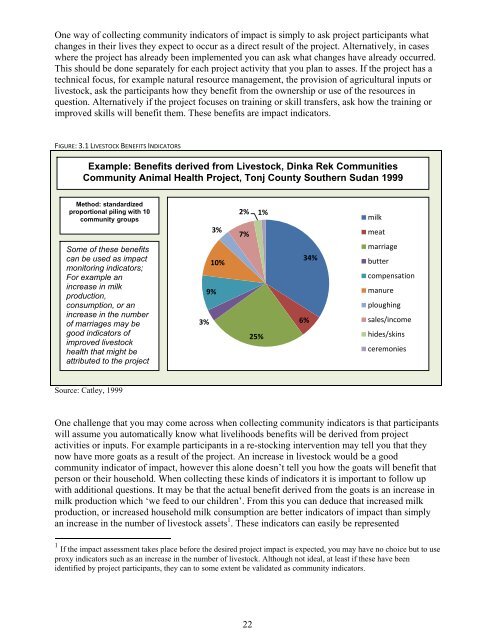Participatory Impact Assessment - Capacity4Dev
Participatory Impact Assessment - Capacity4Dev
Participatory Impact Assessment - Capacity4Dev
Create successful ePaper yourself
Turn your PDF publications into a flip-book with our unique Google optimized e-Paper software.
One way of collecting community indicators of impact is simply to ask project participants what<br />
changes in their lives they expect to occur as a direct result of the project. Alternatively, in cases<br />
where the project has already been implemented you can ask what changes have already occurred.<br />
This should be done separately for each project activity that you plan to asses. If the project has a<br />
technical focus, for example natural resource management, the provision of agricultural inputs or<br />
livestock, ask the participants how they benefit from the ownership or use of the resources in<br />
question. Alternatively if the project focuses on training or skill transfers, ask how the training or<br />
improved skills will benefit them. These benefits are impact indicators.<br />
FIGURE:3.1LIVESTOCKBENEFITSINDICATORS<br />
Example: Benefits derived from Livestock, Dinka Rek Communities<br />
Community Animal Health Project, Tonj County Southern Sudan 1999<br />
Method: standardized<br />
proportional piling with 10<br />
community groups<br />
Some of these benefits<br />
can be used as impact<br />
monitoring indicators;<br />
For example an<br />
increase in milk<br />
production,<br />
consumption, or an<br />
increase in the number<br />
of marriages may be<br />
good indicators of<br />
improved livestock<br />
health that might be<br />
attributed to the project<br />
3%<br />
10%<br />
9%<br />
3%<br />
2% 1%<br />
7%<br />
25%<br />
34%<br />
6%<br />
milk<br />
meat<br />
marriage<br />
butter<br />
compensation<br />
manure<br />
ploughing<br />
sales/income<br />
hides/skins<br />
ceremonies<br />
Source: Catley, 1999<br />
One challenge that you may come across when collecting community indicators is that participants<br />
will assume you automatically know what livelihoods benefits will be derived from project<br />
activities or inputs. For example participants in a re-stocking intervention may tell you that they<br />
now have more goats as a result of the project. An increase in livestock would be a good<br />
community indicator of impact, however this alone doesn’t tell you how the goats will benefit that<br />
person or their household. When collecting these kinds of indicators it is important to follow up<br />
with additional questions. It may be that the actual benefit derived from the goats is an increase in<br />
milk production which ‘we feed to our children’. From this you can deduce that increased milk<br />
production, or increased household milk consumption are better indicators of impact than simply<br />
an increase in the number of livestock assets 1 . These indicators can easily be represented<br />
1 If the impact assessment takes place before the desired project impact is expected, you may have no choice but to use<br />
proxy indicators such as an increase in the number of livestock. Although not ideal, at least if these have been<br />
identified by project participants, they can to some extent be validated as community indicators.<br />
22

















